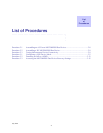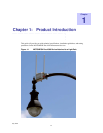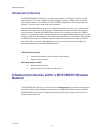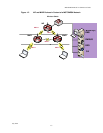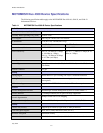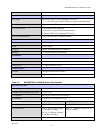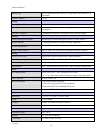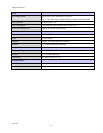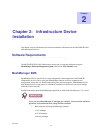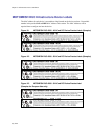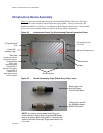
MOTOMESH DUO 2.0 4300 Users Guide
July 2007
1-7
Available Options
Mounting Lamp post mount bracket assembly
Power AC photo cell adapter
Table 1-3 MOTOMESH Duo 4300-54 Device Specifications
Radio Characteristics
Primary Radio Operating Freq. (GHz) 2.400 to 2.483
Secondary Radio Operating Freq. (GHz) 5.470 to 5.725
Wi-Fi Support 802.11b/g at 2.4GHz; 802.11a at 5.4GHz
RF Modulation CCK (802.11b) / OFDM (802.11a/g)
2.4 GHz Portion 5.4 GHz Portion
Output Power (Maximum) 35 dBm EIRP 34 dBm EIRP
Receive Sensitivity 801.11b: -92 dBm (at 11 Mbps)
to -100 dBm (at 1 Mbps)
801.11g: -78 dBm (at 54 Mbps)
to -95 dBm (at 6 Mbps)
802.11a: -77 dBm (at 54 Mbps) to -93
dBm (at 6 Mbps)
Power Control 1dB increments
Antenna Type Two (2) omni directional, 8 dBi (for 2.4 GHz Radio) and 10 dBi (for 5.4
GHz Radio)
Antenna Connector N-Type
Routing
Routing Engine MeshConnex Layer 2 routing with Layer 1 situational-awareness
Routing Protocol Patented, hybrid proactive/reactive routing (low latency & fast route
convergence)
IEEE 802.11s Support Upgradeable to IEEE 802.11s standard via OTA software updates
Network
Network Management Software MeshManager Element Management System via secure SNMP v.3
Network Interface 10/100Mbps Ethernet (RJ-45) port with surge suppression
Network Segmentation
Multiple SSIDs with VLAN mapping
Quality of Service (QoS) 802.11e, EDCF, 802.11p and the IP precedence of DSCP (ToS) bits
Security
Virtual LAN (VLAN) Supports up to sixteen (16) per node, or 4094 per network
Client Encryption Support WEP, WPA (TKIP) and WPA2 (AES, 802.11i)
Internodal Encryption Intra-Mesh Security
Authentication 802.1X (Infrastructure/Client) and MAC address hardware authentication



